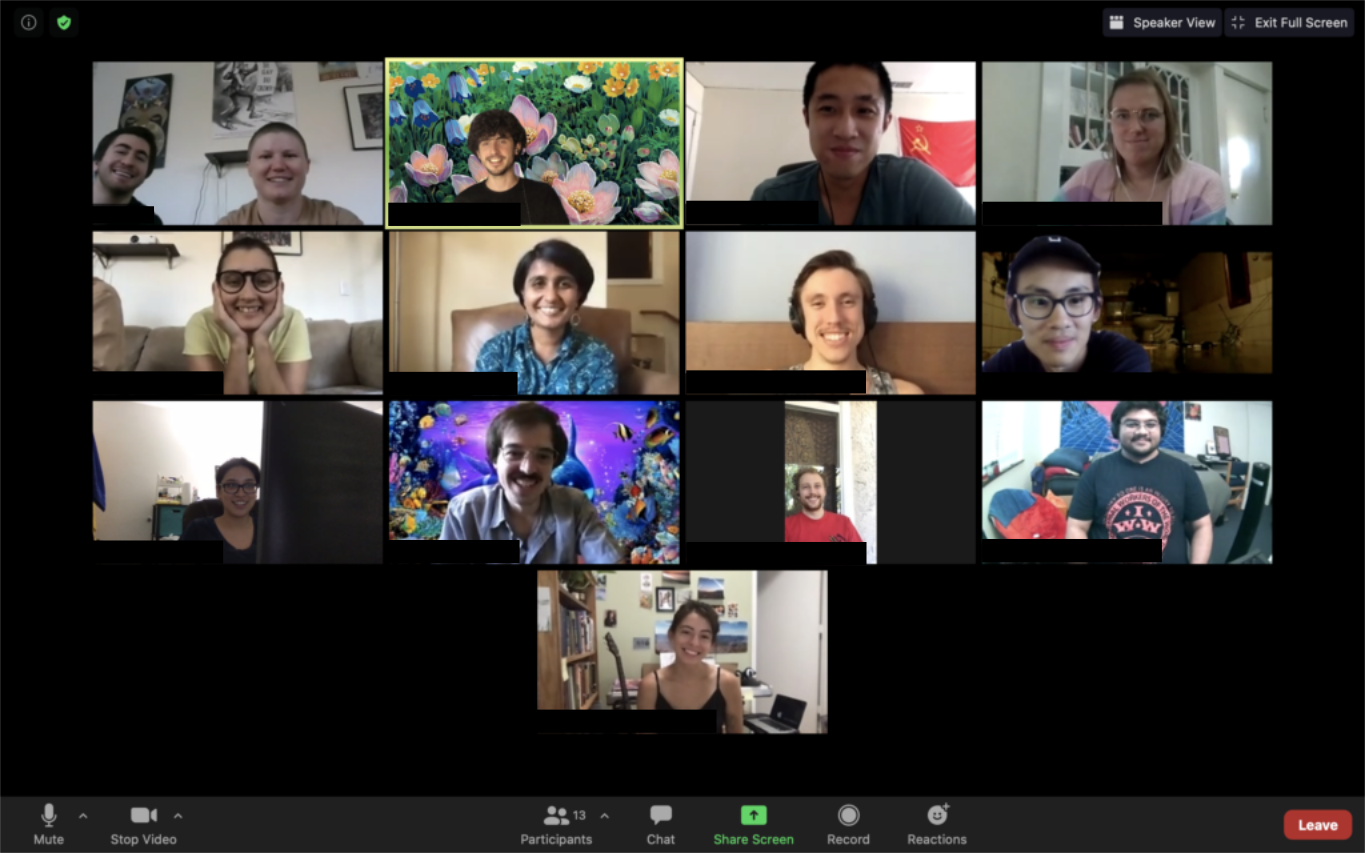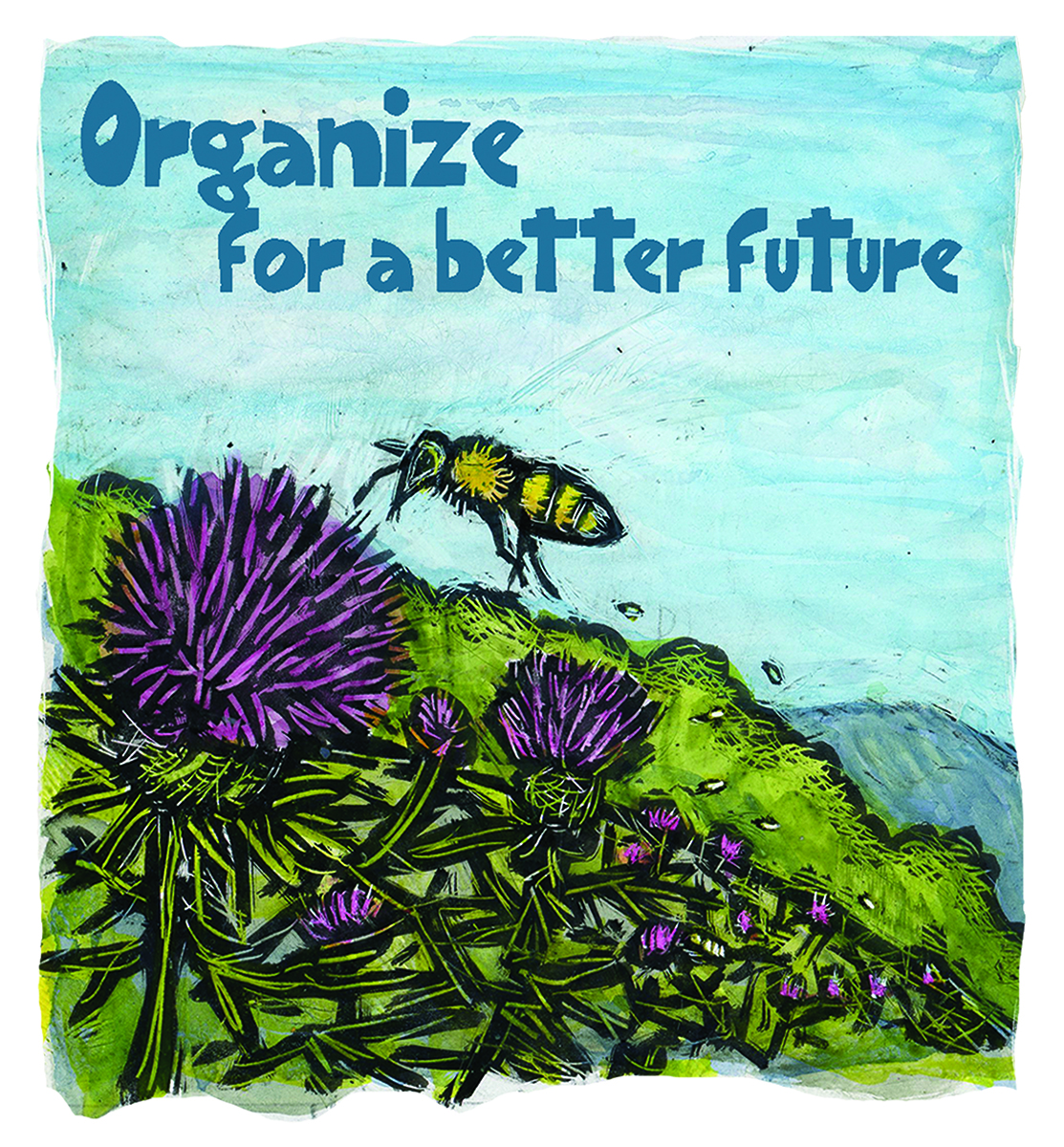Against COVID Austerity
A chapter report from Socialists of Caltech
By Jane Mariam Panangaden, Ashay Naren Patel, & Kriti Sharma on behalf of Socialists of Caltech
Volume 23, number 3, Bio-Politics

On May Day 2020, Socialists of Caltech wrote a response to Caltech administrators’ cutting of graduate student health benefits in the midst of a global pandemic. The following is an edited version of that response, tying the history of eugenics and Caltech’s specific role in its ignoble legacy to the current healthcare struggle.
Contact: socialistsofcaltech.com | Read more organizing reports from SftP chapters here
As the COVID-19 pandemic throws the global economy into crisis, the contradictions at the heart of capitalism have become markedly clear. The failure of the United States to contain the pandemic is a direct result of its other failures: widespread homelessness resulting from privatized housing, forced wage labor at the threat of starvation and eviction, a prison and policing system touted as a panacea for the deficiencies of capitalism, and—perhaps the most relevant failure—the privatized healthcare system.
The current global pandemic reveals the impact of a pernicious worldview that originated in the halls of British and American academia in the late nineteenth century and continues to infect capitalist societies. This ideology, Social Darwinism, asserts that just as the evolutionary pressures of natural selection lead to the survival of species most “fit” to their ecological niche, so do the “fittest” people evolve to thrive in society. Social Darwinism, while presented as natural law, is actually implemented through an economic system that creates the category of disabled people and then oppresses them through exclusion from labor.
In a society where the necessities of life are all commodities to be bought and sold on the market, and where the vast majority can only buy market commodities by working for wages, employment has become life.
Under the capitalist mode of production, those who are “fit” to be employed are those who can most efficiently labor to produce value for an employer. Post-industrialization, capitalists have gained the upper hand in the power struggle with the working class by leveraging the threat of unemployment and subsequent loss of access to the means of survival. This strategy necessitated a production system in which workers can be easily fired and then replaced—like parts of a machine. The means of production thus became standardized for operation by an “average” person whose mind and body does not deviate too much from an idealized norm. Simultaneously, new technology enabled mass production of commodities, which were also “efficiently” designed for use by the “average” consumer.

Disabled people, those who fall far from the “norm” in some way, are exactly those workers who are systematically excluded from labor, even the most meager wealth accumulation, and ultimately participation in society.1 The US Department of Labor defines “disability,” for the purpose of government benefits, as an impairment that prevents working at “substantial gainful activity.”2 Meanwhile, government policies often prevent disabled people from accumulating assets or wealth and incarcerate us in medical and penal institutions.3 The state has also failed to enforce accessibility in most physical spaces, particularly the large fraction that is privately owned, precluding disabled people’s participation both within and outside the workplace.4 The capitalist class has engineered a social system that marginalizes and excludes disabled people while treating our social condition as the consequence of scientific law.
In the late nineteenth century, Social Darwinism birthed a grotesque cluster of concrete policy goals: eugenics. Eugenics aims to accelerate the evolution of the “human race” (a euphemism for the white race) toward a more “advanced” state through human intervention by violently suppressing “undesirables” and encouraging procreation between those with “desirable” traits. The most well-known example of a eugenic project is that of Nazi Germany, which included the T4 euthanasia program, under which an estimated 250,000 disabled people were murdered by medical professionals.5
While Nazi doctors were murdering disabled people in German medical institutions, many politicians, industrialists, and scientists advocated for the compulsory sterilization of Black, Mexican, poor, disabled, incarcerated, and mentally ill people in the US, particularly in Southern California. Among them were Robert Millikan, Caltech’s first president, and Albert B. Ruddock, a Caltech trustee, both of whom were on the board of directors of a eugenic sterilization propaganda and lobbying organization based in Pasadena called the Human Betterment Foundation (HBF) in the 1930s and 1940s.6
The HBF argued that these disabled, poor, and racialized people should be sterilized because they and their offspring were burdens on the US economy, publicly supported state institutions, and the growing welfare state. Under the relentless encouragement of the HBF, doctors and medical superintendents availed themselves of a 1909 California sterilization law to sterilize over 20,000 people in the first half of the twentieth century.7 The HBF’s records suggest that doctors were conducting large numbers of sterilizations on incarcerated and institutionalized people. People were sterilized coercively—for example, as a condition of parole, or without their informed consent—either under the compulsory sterilization law when the victim was deemed “unfit” to consent, or when doctors secretly performed the sterilization concurrently with another surgical procedure, like an appendectomy.
Following its founder’s death in 1942, the HBF’s assets were transferred to Caltech and used to establish a postdoctoral fellowship for research “in those branches of biological science basic to our understanding of human welfare,” though some HBF staff advocated for Caltech to continue the foundation’s line of research directly.8 Following the Second World War, explicitly eugenic policies and mass sterilization practices fell out of public favor. Nevertheless, sterilization quietly continues in prisons and immigration detention centers to this day, and the ideology underpinning eugenics remains deeply embedded in our culture, our workplaces (including academic institutions), and our economic system.9
Campus groups led by the Black Scientists and Engineers of Caltech (BSEC) are pressuring Caltech to rename buildings named after members of the HBF.
In the post-Second World War era, capitalists created two new strategies for using disabled people as a mechanism for capital accumulation. First, disabled peoples’ bodies were transformed into commodities via institutionalization in private healthcare facilities such as nursing homes. Second, disabled people were forced to become consumers of privatized medical services and costly, specialized products. Medical insurance companies play a key role in eugenical strategies because they control what type of care each individual consumer is able to access and how much that care costs. Their coverage policies are also designed for the “average” consumer. A healthy able-bodied person will rarely be forced to pay the myriad out-of-pocket costs built into plans. Furthermore, plans often omit certain services entirely, such as infertility treatments.10 This restricts the ability to reproduce for all but those who can afford the raw cost of these expensive services—impossible for the vast majority of disabled people who are unable to accumulate wealth. At other times, insurance companies impose administrative hurdles, such as denying prior authorization requests for expensive treatments on the basis of opaque, internal criteria.11 It is often precisely these expensive medications that are necessary for disabled people to live.
Universal healthcare was omitted from the New Deal in 1935 due to pressure from medical industry interests who wished to avoid government price controls. Faced with a national wage freeze and a labor shortage during the Second World War, employers used group health insurance plans as a proxy for increased wages.12 At this point, access to medical care became contingent on employment, from which people who most need ongoing care were systematically excluded. In practice, the insurance and medical industries, together with the private sector at large, thus created a eugenic pressure against “unfit” (usually disabled and/or racialized) workers.
In a system where those who are deemed unfit to work are also deemed unfit to live, no one is safe. No one who depends on wages and employment to access the means of survival is safe. Even the non-disabled worker is one accident or health crisis away from disability, and teeters precariously on the edge of unemployment. In a society where the necessities of life are all commodities to be bought and sold on the market, and where the vast majority can only buy market commodities by working for wages, employment has become life.
Attempts at even the modest advance of abolishing the private health insurance industry have been repeatedly stymied in the US over the last century by both Democrats and Republicans in an impressive display of bourgeois class solidarity.13 However, the disunity of the capitalist class presents us with the opportunity to exploit and heighten market contradictions between competing interests: the employers who must provide increasingly expensive health insurance plans to their workers, and the insurance and medical industries themselves. The triple crises of 2020—the COVID-19 pandemic, exceptionally massive West Coast wildfires, and widespread police violence—have heightened contradictions at the authors’ institution, Caltech, where students are advocating against cuts to the student health insurance plan, unsafe workplace conditions, and Caltech’s own racist and eugenical apparatus.14

What of those of us who are not only excluded from work, from the academy, and from healthcare, but are also dehumanized, criminalized, and killed based on a racialized hierarchy of eugenic worth? Here in Los Angeles County in 1992, riots erupted after a jury acquitted police officers who were filmed beating Rodney King, an unarmed Black man. The HBF sheltered and fanned eugenic embers in Pasadena that later set Los Angeles on fire. Eugenicist hierarchies permeated the perceptions of L.A. police officers and the judiciary so deeply that they could not perceive those who deviated from the eugenical “human ideal” as being human at all.15 But human beings resist such mislabelings, right the errors of foolish hierarchy-making, reassert our relations with one another, and call out to one another to be recognized as kin—as evidenced in the still-warm ashes of L.A, where protests in defense of Black lives once again threaten to overturn the eugenicist order.
Following the police murders of George Floyd in Minneapolis and of Anthony McClain in Pasadena in August, campus groups led by the Black Scientists and Engineers of Caltech (BSEC) are pressuring Caltech to rename buildings named after members of the HBF. While this particular reckoning is long overdue, we must be clear that Caltech’s role in perpetuating eugenic violence is not limited to its past association with the HBF.
For instance, the Institute routinely invites Department of Defense (DoD) contractors, Department of Homeland Security (DHS) contractors, and weapons manufacturers to recruit students and postdocs. These firms profit from traumatizing and maiming—and hence disabling—Black and Brown people worldwide. Indeed, one of the members of the task force created to determine whether campus buildings honoring HBF members should be renamed is a trustee of the Institute for Defense Analyses (IDA), which develops so-called “non-lethal” weapons for US police and military, and which have been used liberally against Black Lives Matter protesters in the summer of 2020.16 The IDA assesses the risk of injury and impairment following deployment of these weapons using idealized models of the human body that assume the victim is not disabled, elderly, a child, a cis woman, or someone who deviates from the “norm.”17
In January 2020, the authors of this article disrupted a recruitment session at Caltech by the IDA and an event for Northrop Grumman, which develops technology for the Department of Homeland Security.18 Such on-campus worker solidarity actions must be used to steward these institutions of science towards a just future if they are to survive. But their character must be transformed into something else entirely. At stake is the formation of a new type of university, one in which everyone can participate and share and create knowledge.
Beyond the death-worshipping logic of Social Darwinism, there are liberatory and life-affirming ways to study and conceive the grand history of life. Ours is a living earth that is tremendously generous. We have air to breathe because plants, algae, and bacteria have worked for millions of years to make the atmosphere. These are our common ancestors and this is our common inheritance, what was given to us simply because we are alive, without anyone having to prove their worthiness of it. To those who would bottle and sell the air itself back to us if they could, to those who demand that we earn the lives that we were given, we say, “perhaps you thieves of the commons should prove your worth instead.”
Our demand is simple: to give back to all what was given freely to all. To decommodify what should never have been bottled into sellable packages. To take access to healthcare and all the common wealth of society and of the earth off the market, and to return it to the common use and enjoyment of all. We will generate a science and a society in alignment with a vision of the living world that is worthy of its generosity and splendor.
About the Authors
Find out more about Socialists of Caltech at socialistsofcaltech.com
Jane Mariam Panangaden is a PhD student in Mathematics and an organizer with Socialists of Caltech. Being both multiracial and chronically ill, she has a special place in her heart for destroying all modern incarnations of eugenic ideology and practice.
Ashay Naren Patel is a PhD student in Physics at Caltech where he organizes with the Socialists of Caltech, Caltech for Affordable Healthcare, and Caltech for Black Lives around a wide variety of issues including anti-imperialism, housing justice, racial justice, and healthcare access.
Kriti Sharma, PhD, is a postdoctoral scholar in Geobiology at the California Institute of Technology (Caltech), where she studies microbial life in sediments at the bottom of the ocean, and organizes with Socialists of Caltech. She is the author of Interdependence: Biology and Beyond (Fordham University Press, 2015).
References
- Michelle Maroto and David Pettinicchio, “Twenty-five Years After the ADA: Situating Disability In America’s System of Stratification,” Disability Studies Quarterly 35, no. 3 (2015), https://dsq-sds.org/article/view/4927/4024.
- “Frequently Asked Questions – General,” Office of Disability Employment Policy, US Department of Labor, accessed September 2020, https://www.dol.gov/odep/faqs/general.htm#3.
- Bethany K. Laurence, “How Much Can I Have in Assets and Still Be Eligible for Disability Benefits?” Disability Secrets, accessed September 2020, https://disabilitysecrets.com/how-much-can-i-have-in-assets-and-get-disability.html; Jody Santos, “‘Prisons Without Bars’ – Forced Institutionalization of People with Disabilities,” Mad in America, October 22, 2017, https://www.madinamerica.com/2017/10/forced-institutionalization-people-disabilities/.
- National Disability Policy: A Progress Report: Has the Promise Been Kept? Federal Enforcement of Disability Rights Laws, National Council on Disability, October 31, 2018.
- United States Holocaust Memorial Museum, “Euthanasia Program,” Holocaust Encyclopedia, updated October 7, 2020, https://encyclopedia.ushmm.org/content/en/article/euthanasia-program.
- Colette Leung, “Human Betterment Foundation,” Eugenics Archive, September 13, 2013, eugenicsarchive.ca/discover/connections/52337e635c2ec50000000053.
- Lutz Kaelber, “California Eugenics,” Eugenics: Compulsory Sterilization in 50 American States, University of Vermont, accessed September 2020, https://www.uvm.edu/~lkaelber/eugenics/CA/CA.html.
- George Wells Beadle, “The Gosney Research Fund,” Engineering and Science 10 (May 1947): 27; Register of the E. S. Gosney Papers And Records Of The Human Betterment Foundation, 1880-1945, California Institute of Technology, last modified July 1998, https://oac.cdlib.org/findaid/ark:/13030/tf2h4n98gb/entire_text/.
- Nicole Knight, “Thousands Were Sterilized Under California’s Eugenics Law: Now Survivors Could Get Reparations,” Rewire News Group, April 19, 2018; Molly O’Toole, “19 Women Allege Medical Abuse in Georgia Immigration Detention,” Los Angeles Times, last modified October 23, 2020, https://www.latimes.com/politics/story/2020-10-22/women-allege-medical-abuse-georgia-immigration-detention; Register of the E. S. Gosney Papers.
- “Infertility Coverage By State,” RESOLVE: The National Infertility Association, accessed September 2020, https://resolve.org/what-are-my-options/insurance-coverage/infertility-coverage-state.
- “2017 AMA Prior Authorization Physician Survey,” American Medical Association, 2018.
- Stephanie Buck, “Universal Health Care Was Almost Part of the Original Social Security Act of 1935,” Timeline, June 15, 2017.
- Eric Blanc, “Why Did Labor Leaders Vote Against Medicare for All in the Middle of a Pandemic?,” Jacobin, July 29, 2020, jacobinmag.com/2020/07/democratic-party-platform-medicare-for-all-unions.
- Caltech for Affordable Healthcare, accessed October 2020, https://caltechgradhealth.com.
- Sylvia Wynter, “No Humans Involved,” New Frame, April 29, 2019.
- “IDA Board of Trustees,” Institute for Defense Analyses (IDA), accessed October 2020, https://www.ida.org/en/about-ida/leadership/board-of-trustees.
- Shelley Cazares, James Belanich, Jeffrey A. Snyder, P.M. Piccuci, and Jenny R. Holzer, Institute for Defense Analyses, “Measures of Effectiveness for Non-Lethal Weapons: Aligning Test & Evaluation with Operational Success,” presented July 22, 2014, at 29th Annual National Test & Evaluation Conference, Washington DC; Bosco Buchannon, “Community Members Say Anthony Mcclain Killing Was Uncalled For and Unjustifiable,” Pasadena Black Pages, August 15, 2020; Dhruvi Chauhan, Paula Kibuka Musoke, and Goleen Samari, “Using Tear Gas on Protesters Perpetuates Patterns of Reproductive Harm,” The Hill, June 26, 2020.
- “EAGLE II (DHS),” Northrop Grumman, accessed October 2020, https://www.northropgrumman.com/eagle-ii-dhs/.





